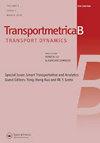信号交叉口安全与机动的实时多目标优化
IF 3.4
2区 工程技术
Q2 TRANSPORTATION
引用次数: 4
摘要
本文章由计算机程序翻译,如有差异,请以英文原文为准。
Real-Time multi-objective optimization of safety and mobility at signalized intersections
ABSTRACT Adaptive Traffic Signal Control (ATSC) is becoming a popular dynamic traffic management technique, especially with the emerging connected vehicles (CVs) technology. ATSC algorithms have been extensively considered in the literature for enhancing traffic mobility at signalized intersections. However, improving safety has rarely been used as an objective in existing ATSC algorithms. To fill this gap, this paper proposes a multi-criteria reinforcement learning based ATSC algorithm with two optimization objectives: real-time safety and mobility. The algorithm was trained on both objectives using traffic simulation. The safety objective was considered using extreme value theory (EVT) real-time crash risk evaluation models. Reducing the total intersection delay was the mobility objective. Different weights were considered in the training to account for both objectives simultaneously. The performance of the trained algorithm was then validated using real-world video data. Results show that the proposed multi-objective algorithm can improve both safety and mobility even under lower weights.
求助全文
通过发布文献求助,成功后即可免费获取论文全文。
去求助
来源期刊

Transportmetrica B-Transport Dynamics
TRANSPORTATION SCIENCE & TECHNOLOGY-
CiteScore
5.00
自引率
21.40%
发文量
53
期刊介绍:
Transportmetrica B is an international journal that aims to bring together contributions of advanced research in understanding and practical experience in handling the dynamic aspects of transport systems and behavior, and hence the sub-title is set as “Transport Dynamics”.
Transport dynamics can be considered from various scales and scopes ranging from dynamics in traffic flow, travel behavior (e.g. learning process), logistics, transport policy, to traffic control. Thus, the journal welcomes research papers that address transport dynamics from a broad perspective, ranging from theoretical studies to empirical analysis of transport systems or behavior based on actual data.
The scope of Transportmetrica B includes, but is not limited to, the following: dynamic traffic assignment, dynamic transit assignment, dynamic activity-based modeling, applications of system dynamics in transport planning, logistics planning and optimization, traffic flow analysis, dynamic programming in transport modeling and optimization, traffic control, land-use and transport dynamics, day-to-day learning process (model and behavioral studies), time-series analysis of transport data and demand, traffic emission modeling, time-dependent transport policy analysis, transportation network reliability and vulnerability, simulation of traffic system and travel behavior, longitudinal analysis of traveler behavior, etc.
 求助内容:
求助内容: 应助结果提醒方式:
应助结果提醒方式:


